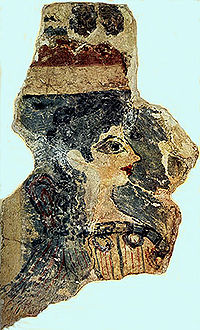- La Parisienne
-
- This is about the Minoan fresco. For the painting by Filipino painter Felix Resurreccion Hidalgo, see La Parisienne (painting).
 La Parisienne Heraklion Archaeological Museum About 1400 BC
La Parisienne Heraklion Archaeological Museum About 1400 BC
La Parisienne also known as the Minoan Lady, is part of the Camp Stool Fresco, which was probably painted on the wall of the Sanctuary Hall on the Piano Nobile at the palace of Knossos. The sacral knot worn at the back of the neck seems to indicate that she is a priestess or even a goddess. The archaeological research in Minoan palaces, cemeteries and settlements has brought to light a multitude of objects related to beautification.
It seems that there were beautification areas in the palaces of Knossos, Zakros and Pylos. These beauty objects were used during the whole Aegean Bronze Age. By using these objects, the Minoan ladies highlighted the red lips and the white of the face. In the fresco of the Parisienne, the use of the black colour for emphasizing the form of the eyes and red for the lips can clearly be seen.
It dates from the Neopalatial period, ca. 1400 B.C., and is currently in the Herakleion Archaeological Museum.
Bibliography
- A. Evans, The Palace of Minos at Knossos III repr. New York 1964
- A. Papaefthymiou-Papanthimou Utensils and toiletries of the Cretan-Mycenaean Age, Thessaloniki 1979
- Poursat, J.C., Les Ivoires myceniens, Paris 1977
- Palmer L, The Interpretation of Mycenaean Greek Texts, Oxford 1963.
External links
Categories:- Minoan frescos
- Ancient peoples
- Minoan civilization
- Civilizations
- Ancient Greece
- Ancient Greece stubs
Wikimedia Foundation. 2010.
